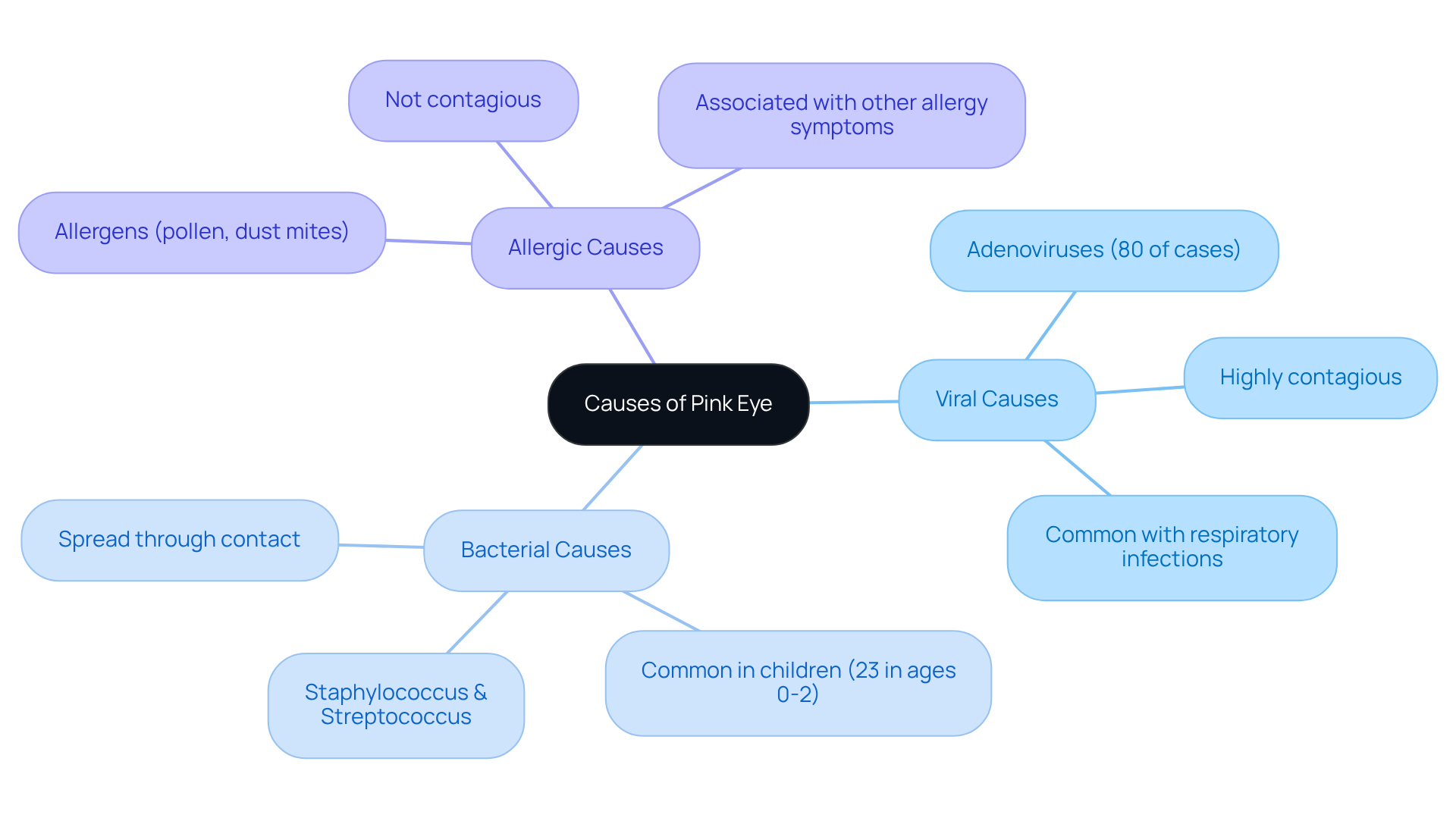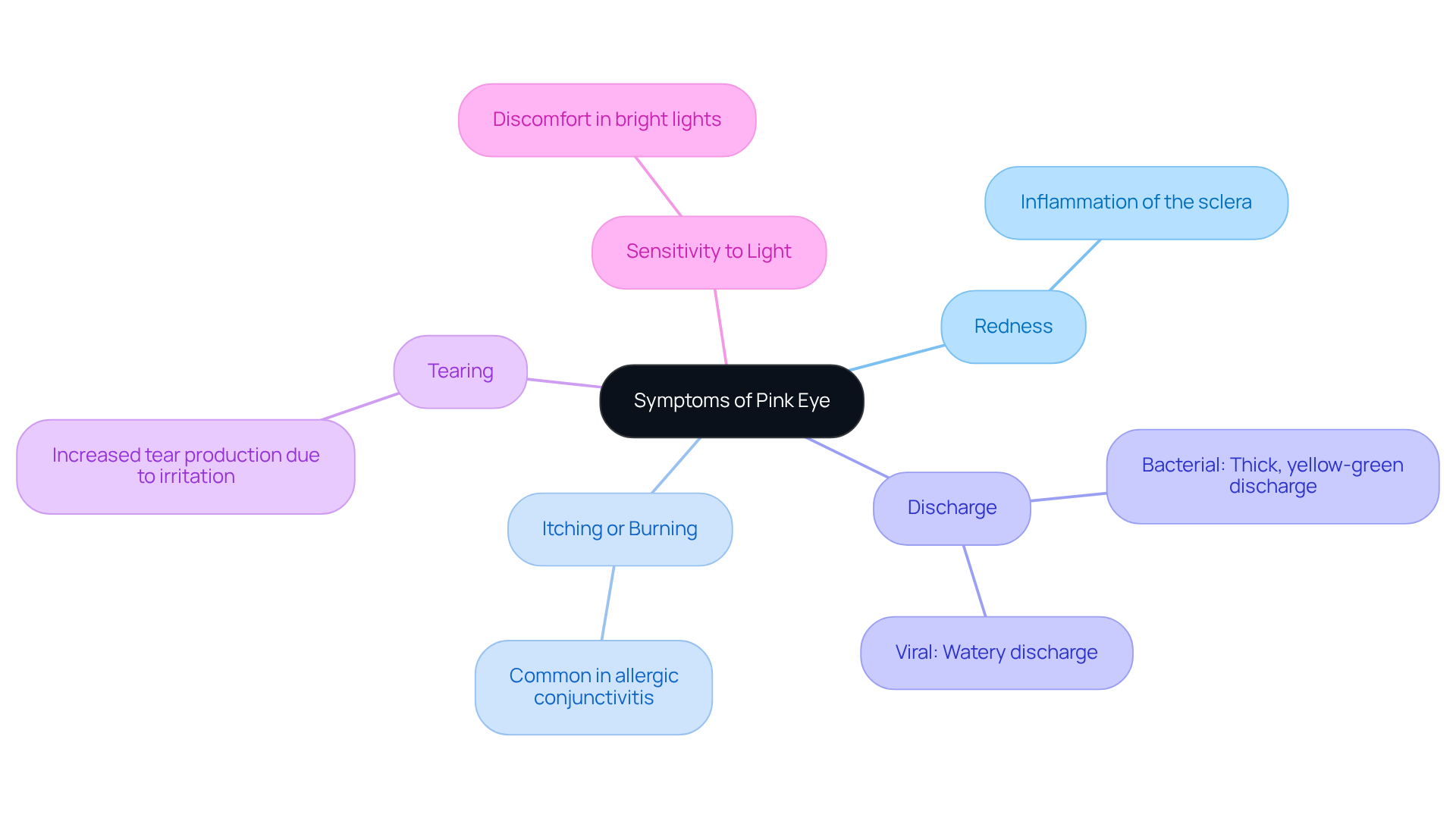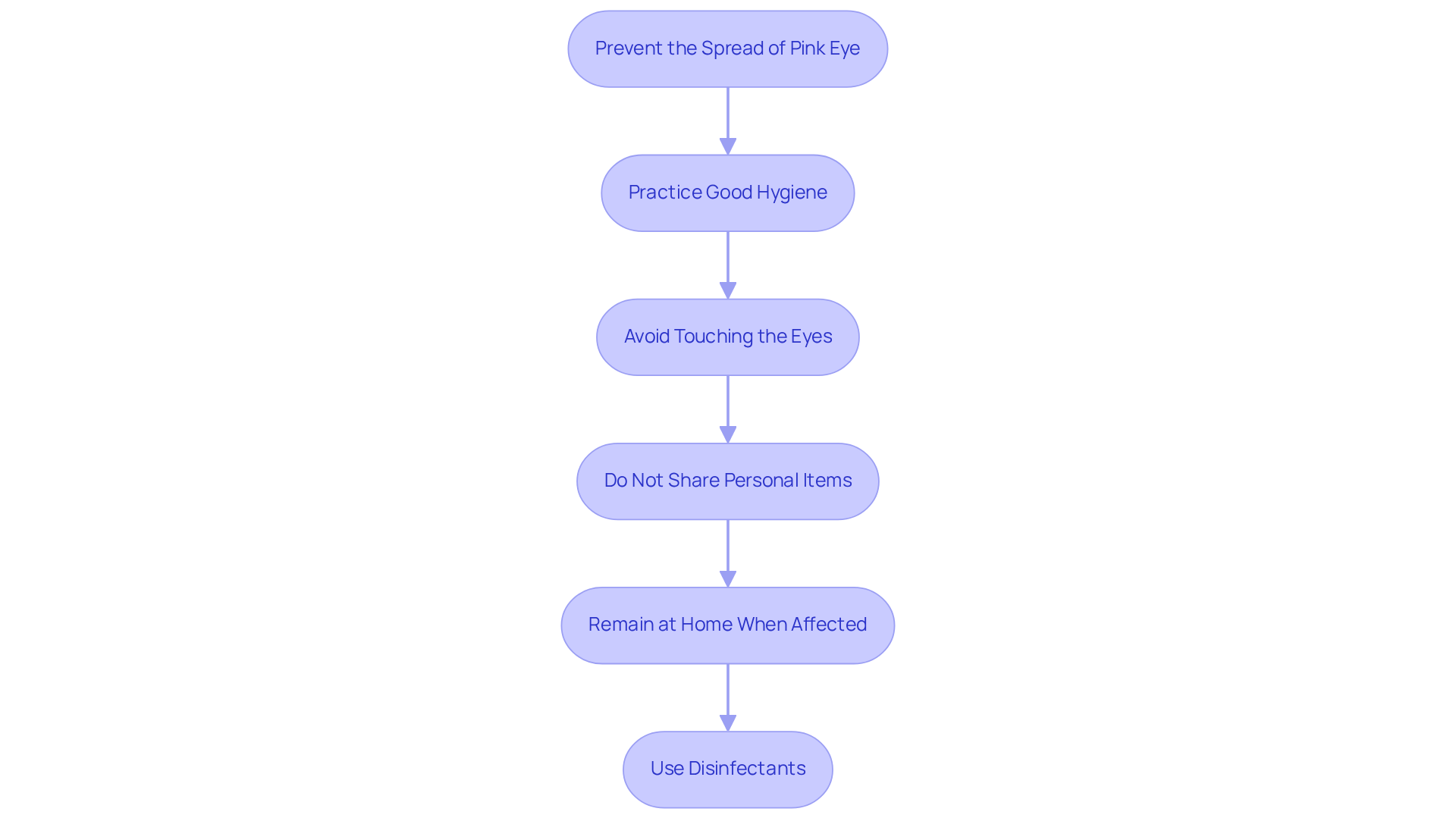Posted by: Northwest Eye in General on November 4, 2025
Overview
We understand that dealing with pink eye, or conjunctivitis, can be concerning. It’s important to know that this condition is primarily contagious through direct contact with infected individuals or contaminated surfaces, rather than being spread through the air. While respiratory droplets can carry the virus or bacteria, effective hygiene practices and avoiding close contact are crucial in preventing transmission.
It’s common to feel anxious about how easily pink eye can spread, but rest assured that by practicing good hygiene, you can significantly reduce the risk of infection. Remember, pink eye is not considered airborne, which should provide some reassurance.
We are here to help you through this process and encourage you to take proactive steps to protect yourself and others. If you have any further questions or concerns, don’t hesitate to reach out for support.
Introduction
Understanding the nuances of pink eye, or conjunctivitis, is essential for anyone concerned about eye health. We understand that this condition can be worrying, especially with various types—viral, bacterial, and allergic—each presenting unique symptoms and treatment paths. You might be wondering: is pink eye contagious by air? This article delves into the causes and transmission methods, offering valuable insights into prevention strategies that can help mitigate the spread of this common condition.
It’s common to feel anxious about whether one can truly catch pink eye from the air, or if it’s primarily spread through direct contact. Exploring these questions is key to safeguarding both personal and public health. We are here to help you through this process, providing the information you need to feel more secure and informed.
Understand Pink Eye: Definition and Types
Pink eye, or conjunctivitis, can be concerning, and we understand how it might make you feel. This inflammation affects the conjunctiva, the thin, transparent layer covering the white part of your eyeball and the inner eyelids. There are three primary types of pink eye:
-
Viral Conjunctivitis: Often caused by viruses linked to colds, this type is highly contagious but usually resolves on its own within one to two weeks. You might notice watery discharge and redness, which can be uncomfortable, but rest assured, it typically doesn’t require medical intervention.
-
Bacterial Conjunctivitis: This form is caused by bacteria and can lead to more severe symptoms, such as pus discharge and significant discomfort. If you experience these symptoms, it’s important to seek treatment, as antibiotics may be necessary, especially if corneal inflammation is present. While bacterial infections are less common, it raises the question: is pink eye contagious by air, as they can spread quickly in close-contact environments like schools and daycare centers.
-
Allergic Conjunctivitis: Triggered by allergens like pollen, pet dander, or smoke, this type is characterized by itching, redness, and watery eyes. The good news is that allergic conjunctivitis isn’t contagious and can often be managed with antihistamines and by avoiding allergens.
Understanding these types is crucial for determining the right response and treatment options. Statistics suggest that viral eye infections make up the majority of cases, with most resolving on their own within one to two weeks. However, if symptoms persist beyond this period, we encourage you to visit a healthcare professional to rule out more serious conditions.
Recent studies highlight the importance of hygiene practices, such as regular hand washing and sanitizing frequently touched surfaces, to prevent the transmission of both viral and bacterial infections. Remember, we are here to help you through this process, and taking these steps can make a significant difference in your recovery.

Identify Causes of Pink Eye: Viral, Bacterial, and Allergic
Understanding pink eye can feel overwhelming, but we’re here to help you through it. The causes of pink eye can be categorized into three main groups:
-
Viral Causes: Viral eye inflammation is predominantly caused by adenoviruses, which account for about 80% of cases. It is important to understand that is pink eye contagious by air, as this type spreads easily through respiratory droplets or direct contact with contaminated surfaces. It’s common to feel anxious about the contagious nature of viral eye infections, particularly regarding if is pink eye contagious by air, especially in communal settings where outbreaks can happen quickly.
-
Bacterial Causes: Bacterial eye infections often stem from pathogens like Staphylococcus and Streptococcus. They spread through direct contact with infected individuals or contaminated objects, making hygiene practices crucial. We understand that this can be particularly concerning for parents, as bacterial eye infections are especially common in children, with seasonal peaks during winter months. In fact, studies show that bacterial eye infections account for about 1% of all primary care consultations in the United States, highlighting how prevalent they are.
-
Allergic Causes: Allergic eye inflammation occurs when the immune system reacts to allergens such as pollen or dust mites. Unlike viral and bacterial forms, it’s not contagious. You might also notice other allergy symptoms, like sneezing or a runny nose, which can add to your discomfort.
Recognizing whether is pink eye contagious by air is vital for appropriate treatment and preventing further spread, especially in environments where close contact is common. Remember, we are here to support you through this process.

Recognize Symptoms of Pink Eye: Key Indicators
If you’re experiencing symptoms of pink eye, or conjunctivitis, it’s important to know that you’re not alone. Many people face similar concerns, and understanding what to look for can help you feel more at ease. Here are some common symptoms:
- Redness: You might notice that the sclera, or the white part of your eye, appears pink or red. This is a sign of inflammation.
- Itching or Burning: These sensations are especially common in cases of allergic eye inflammation, and they can be quite bothersome.
- Discharge: If you have a bacterial infection, you may see a thick, yellow-green discharge. In contrast, a viral infection usually leads to a watery discharge.
- Tearing: Increased tear production often occurs as a response to irritation or infection.
- Sensitivity to Light: Bright lights may cause discomfort, which can make your symptoms feel worse.
Recognizing these signs early is crucial. It can lead to prompt treatment, which significantly reduces the risk of spreading the infection. We understand that navigating these symptoms can be stressful, but knowing what to look for empowers you to take action. Eye care specialists emphasize that being aware of these key indicators allows for timely medical intervention, which is essential for effective management and recovery.
Recent studies have shown that untreated eye infections can lead to serious complications. That’s why it’s so important to stay informed about the symptoms. Remember, we are here to help you through this process, and seeking care when you notice these signs can make all the difference.

Evaluate Transmission: Is Pink Eye Airborne?
It’s important to understand how pink eye, or conjunctivitis, spreads and to ask the question, is pink eye contagious by air? Unlike respiratory viruses, the question of whether is pink eye contagious by air arises, as pink eye is primarily transmitted through direct contact with infected individuals or contaminated surfaces. While it’s not airborne, respiratory droplets from a cough or sneeze can carry the virus or bacteria, leading to transmission, which makes one wonder, is pink eye contagious by air? Here are the key ways it spreads:
- Direct Contact: This happens when you touch someone who is infected or come into contact with their belongings, like clothing or personal items.
- Contaminated Surfaces: Touching surfaces such as doorknobs, towels, or shared items that have been contaminated can help spread the infection.
- Respiratory Droplets: Although not airborne, being close to someone who is infected can lead to droplets landing on your face, prompting the question, is pink eye contagious by air?
We understand that knowing how pink eye spreads can be overwhelming. That’s why it’s essential to implement effective prevention strategies. Frequent hand washing and avoiding sharing personal items are critical steps in reducing your risk of infection. Additionally, if you’re experiencing an active infection, it’s advisable to refrain from wearing contact lenses to prevent further complications.
Remember, you’re not alone in this. We are here to help you through this process and support you in staying healthy.

Implement Prevention Strategies: Avoid Spreading Pink Eye
To effectively prevent the spread of pink eye, we understand that you may have concerns about whether pink eye is contagious by air. Here are some caring strategies to help you:
-
Practice Good Hygiene: Regular handwashing with soap and water is essential, especially after touching your face or skin. This simple act can significantly reduce the risk of infection transmission. Did you know that kids in public schools across the U.S. miss nearly 3 million days of school every year because of pink eye? This highlights just how important hygiene practices are.
-
Avoid Touching the Eyes: It’s common to feel the urge to rub or touch your eyes, but refraining from this can minimize irritation and the potential for spreading infection. Direct contact can transfer pathogens. Dr. Jasmeet Singh Bhogal emphasizes, “It’s important that you don’t delay your medical needs or overlook signs that would typically prompt you to seek care.”
-
Do Not Share Personal Items: Sharing towels, pillows, or makeup can lead to contamination. Keeping your personal belongings distinct is crucial to lessen the risk of transmitting conjunctivitis.
-
Remain at Home When Affected: If you find yourself with conjunctivitis, it’s best to stay home from work or school until the signs resolve. This helps prevent the infection from spreading to others, as it raises the question of whether pink eye is contagious by air, meaning individuals are contagious as long as symptoms are present. Remember, children don’t need to be excluded from school unless they show additional exclusion criteria like fever or behavioral changes.
-
Use Disinfectants: Regularly cleaning surfaces that may harbor contaminants, such as doorknobs and shared electronics, is vital. Good cleaning practices can help control outbreaks, especially in communal settings. A case study on the significance of notifying health authorities about suspected outbreaks shows how effective communication can assist in managing and preventing the spread of conjunctivitis.
By following these strategies, you can significantly lower your chances of contracting or transmitting pink eye. We are here to help you through this process, contributing to overall public health safety.

Conclusion
Understanding pink eye, or conjunctivitis, is essential for effectively managing and preventing its spread. We know that this condition can arise from various causes, including viral, bacterial, and allergic factors, each with distinct symptoms and treatment approaches. While it’s common to wonder whether pink eye is contagious by air, it’s important to recognize that the primary modes of transmission involve direct contact and contaminated surfaces rather than airborne particles.
Throughout this guide, we’ve highlighted key insights, such as the importance of recognizing symptoms like redness, discharge, and irritation. These signs can lead to timely medical intervention, which is crucial for your well-being. Hygiene practices, including regular hand washing and avoiding the sharing of personal items, play a vital role in preventing the transmission of both viral and bacterial forms of conjunctivitis. Additionally, understanding the nature of allergic conjunctivitis reassures us that it poses no risk of contagion.
Ultimately, awareness and proactive measures are the cornerstones of preventing pink eye. By implementing effective hygiene strategies and remaining informed about the symptoms and transmission methods, you can significantly reduce your risk of infection and contribute to the overall health of your community. Taking these steps not only protects yourself but also safeguards others, reinforcing the importance of public health practices in managing conjunctivitis outbreaks. We are here to help you through this process, ensuring you feel supported every step of the way.






